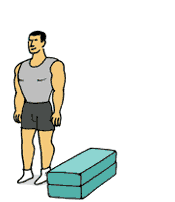Shape Up
Strategies for being in top physical condition
- Dave Grossi | From the March 2012 Issue | Tuesday, March 20, 2012
Is physical fitness important in our line of work? It was for these men.
Incident #1: It’s been more than 25 years since the infamous FBI shoot-out in Miami in which two agents were killed and five others were wounded. To most cops, it’s an anecdote on firepower: 9 mm vs. .45 ACP. But to the late Supervisory Special Agent Gordon McNeil, it was much more. Besides losing two of his best friends, Special Agents Ben Grogan and Jerry Dove, McNeil himself suffered a serious neck wound during the firefight. In fact, the docs who attended him said if it hadn’t been for the muscle mass in his neck (McNeil was an avid power lifter) he might have suffered permanent paralysis from the round that struck him.
Incident #2: A prowler shot a rookie cop (from my former agency) in the leg during a domestic violence response. The round from a .357 Magnum destroyed his femoral artery. The cop was an avid skier, a committed runner and had only been out of the academy a few months. That confluence of conditioning, according to our police surgeon, was what saved him, despite his blood pressure dropping to a dangerous 60/30 (a normal blood pressure is around 120/80) by the time he reached the hospital.
Incident #3: In a confrontation between members of the NYPD and the Pagans Motorcycle Club, an officer was knocked to the ground, badly beaten and nearly disarmed. He managed to keep control of his sidearm, turned the barrel toward his assailant and pulled the trigger. The officer’s blood pressure by the time he reached the hospital was an astounding 230/110. His excellent physical conditioning allowed him to survive both the life-and-death fight and the emotional aftermath.
So is physical fitness important? You bet! But not just from an officer survival standpoint. The emotional stress of this job (e.g., court, the administration, internal affairs [IA], civil rights lawsuits, transfers, marital strife) can be overwhelming. Physical fitness in law enforcement can aid you in dealing with the typical (and atypical) offender. You should consider what kind of physical fitness program is best for the average street cop, and the importance of physical fitness from a legal standpoint.
Dealing with Offenders
“Every day you don’t work out, your enemy is.” Jerry Konrad, a Certified Fitness Specialist and a retired police sergeant, uses this phrase to remind his students about today’s dangers on the street—and he’s right. Although many penal institutions have removed weight-training equipment from their facilities, there’s still plenty of physical fitness training taking place. Our U.S. criminal justice system ensures that every state and federal prisoner has a healthy, properly balanced diet and nutrition program designed by the most competent registered dietitians. Medical care? Well, that’s free, too.
Remember: Your assailant’s average age is always going to be around 25 years old. So while you’re seasoning and maturing (read: getting older), your adversary won’t. Bottom line: The assailant will be younger, probably in better shape and undoubtedly better armed. Sure, they’ll always be looking over their shoulder for “the man” while they’re at “work,” but they’re not going to have the stress of IA, a Citizen’s Review Board, or the thousands of civil rights attorneys or “gotcha” TV reporters watching their every move.
Choosing the Right Program
So it’s time to get in shape. What’s the best strategy for coming up with an exercise program? My wife and I have participated in a SWAT Fitness Academy program for the last several years. Run by an internist MD and coached by several sheriffs’ office SWAT Cross Fit trainers, the program includes weight training and strength training, as well as running and calisthenics.
Konrad recommends that older and “de-conditioned” personnel should engage in 30 minutes of moderate activity three times a week as a good start to improving fitness level. Some trainers subscribe to the “20 minutes four times a week” rule or the “50 for 5” program (50 minutes five days a week). What’s important is getting up to your target heart rate (generally 220 beats/minute minus your age) and maintaining it for the duration of your workout. Whatever your off-duty time and work schedule permits, make sure your fitness program isn’t sabotaged by a lousy diet, smoking or excessive alcohol ingestion. Also, check with your personal physician or agency doctor before beginning any exercise regimen.
Physical Fitness & the Law
With regard to the liability aspect of physical fitness, you can’t afford not to be in peak condition. Double check with your agency legal beagles, but here’s a case street cops and administrators may want to consider.
Two Metro D.C. cops were on the hunt for a parolee, Donald Parker, a suspect in several drugstore robberies. They found him in neighboring Prince Georges County, Md. After initially agreeing to accompany the officers back to D.C., Parker fled. A chase ensued after he carjacked a motorist’s car and eventually smashed it into the pursuing police vehicle. One of the officers tried unsuccessfully to remove Parker from the vehicle. When the officer saw Parker make a sudden move toward his waist area (the result of the female carjack victim dumping her steaming cup of coffee onto Parker’s lap), the officer fired four times at Parker.
Parker sued the city and the U.S. Court of Appeals sustained his $500,000 jury award. This was attributed in part to the officer’s admission during the trial that he’d received only two 30-minute training sessions of empty-handed control techniques since his basic academy training years earlier and had been cited several times for being overweight and “not in adequate shape” to do his job. The court stated: “Given [the officer’s] physical condition, it is not hard to fathom that his most effective method for subduing the objects of his pursuits would be the use of a firearm as opposed to the application of physical force.”
Final Words
Although this article can’t provide a full education on how to establish a physical fitness program for your agency, we hope it motivates you to start looking after your physical well-being. If you have fitness facilities, a gym or an exercise area at your agency, but haven’t visited it recently, get started. If you don’t have a place to work out, explore some options. Check with local fitness trainers to see what’s out there in your neighborhood. And if you’re looking for some help in establishing a fitness program or setting up some fitness standards for yourself or your agency, contact Konrad. He’ll be glad to help.
Jerry Konrad, fitness guru, assisted in the writing of this column. For information on establishing a physical fitness program at your agency, contact him at 727/743-3407 or http://www.lawofficer.com/article/training/JKonrad@aliveawareandwell.com.
References
1. Parker v. the District of Columbia, 850 F.2d 708 (1988).


 Squat Jumps
Squat Jumps Jump to Box
Jump to Box Lateral Jump to Box
Lateral Jump to Box Split Squat Jumps
Split Squat Jumps Tuck Jumps
Tuck Jumps Lateral Box Push Offs
Lateral Box Push Offs Bounding
Bounding Bounding with Rings
Bounding with Rings Box Drill with Rings
Box Drill with Rings
 Zigzag Hops
Zigzag Hops Single Leg Lateral Hops
Single Leg Lateral Hops Depth Jumps
Depth Jumps
 Your thyroid gland is a small gland, normally weighing less than one ounce, located in the front of the neck. It is made up of two halves, called lobes, that lie along the windpipe (trachea) and are joined together by a narrow band of thyroid tissue, known as the isthmus.
Your thyroid gland is a small gland, normally weighing less than one ounce, located in the front of the neck. It is made up of two halves, called lobes, that lie along the windpipe (trachea) and are joined together by a narrow band of thyroid tissue, known as the isthmus.

 The thyroid gland is under the control of the pituitary gland, a small gland the size of a peanut at the base of the brain (shown here in orange). When the level of thyroid hormones (T3 & T4) drops too low, the pituitary gland produces Thyroid Stimulating Hormone (TSH) which stimulates the thyroid gland to produce more hormones. Under the influence of TSH, the thyroid will manufacture and secrete T3 and T4 thereby raising their blood levels. The pituitary senses this and responds by decreasing its TSH production. One can imagine the thyroid gland as a furnace and the pituitary gland as the thermostat. Thyroid hormones are like heat. When the heat gets back to the thermostat, it turns the thermostat off. As the room cools (the thyroid hormone levels drop), the thermostat turns back on (TSH increases) and the furnace produces more heat (thyroid hormones).
The thyroid gland is under the control of the pituitary gland, a small gland the size of a peanut at the base of the brain (shown here in orange). When the level of thyroid hormones (T3 & T4) drops too low, the pituitary gland produces Thyroid Stimulating Hormone (TSH) which stimulates the thyroid gland to produce more hormones. Under the influence of TSH, the thyroid will manufacture and secrete T3 and T4 thereby raising their blood levels. The pituitary senses this and responds by decreasing its TSH production. One can imagine the thyroid gland as a furnace and the pituitary gland as the thermostat. Thyroid hormones are like heat. When the heat gets back to the thermostat, it turns the thermostat off. As the room cools (the thyroid hormone levels drop), the thermostat turns back on (TSH increases) and the furnace produces more heat (thyroid hormones).